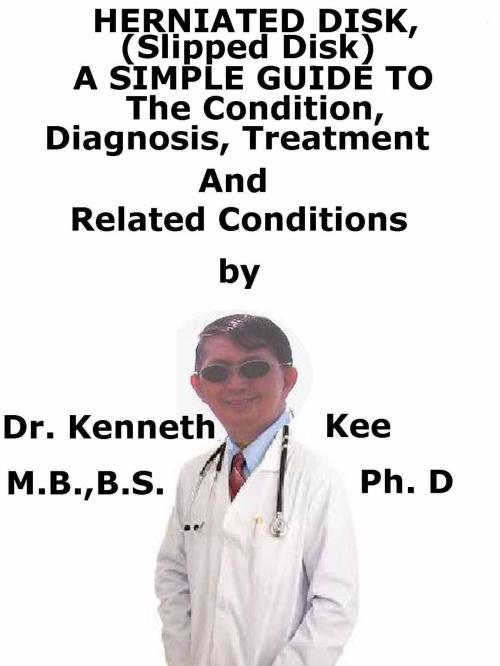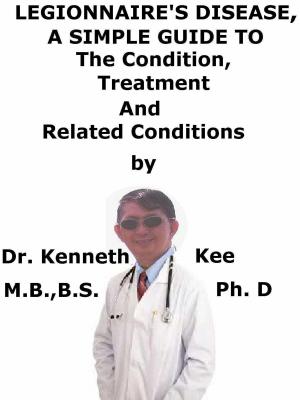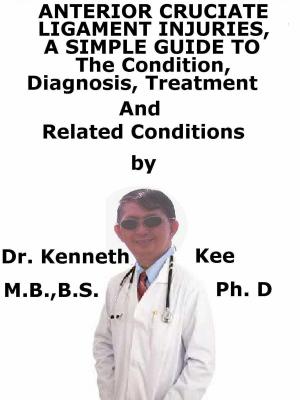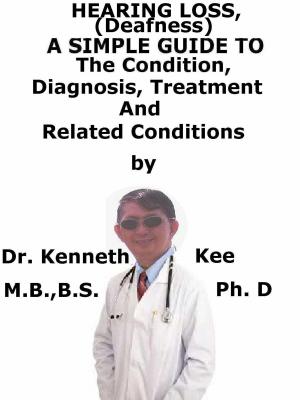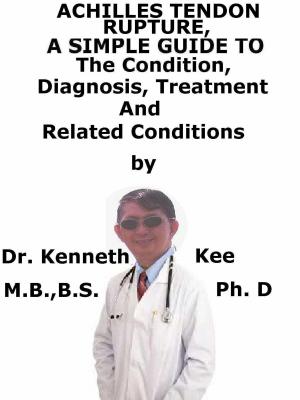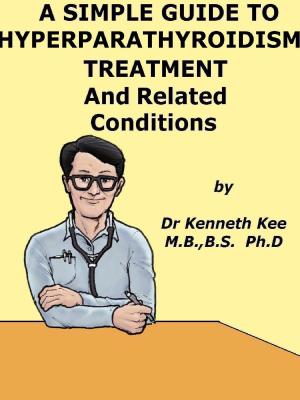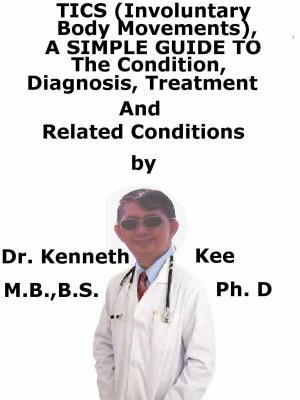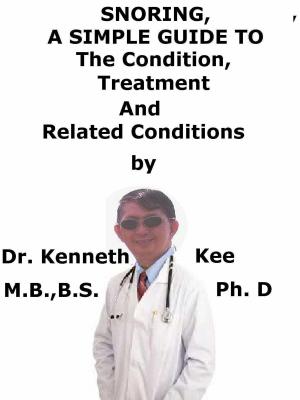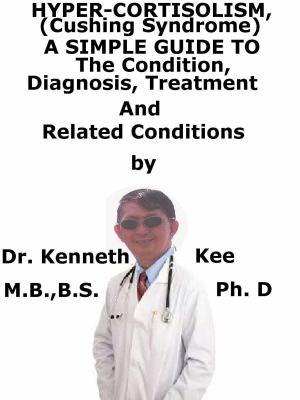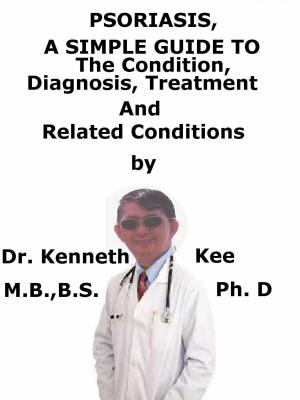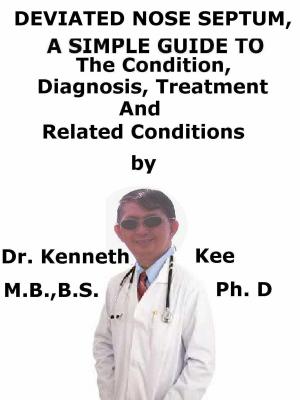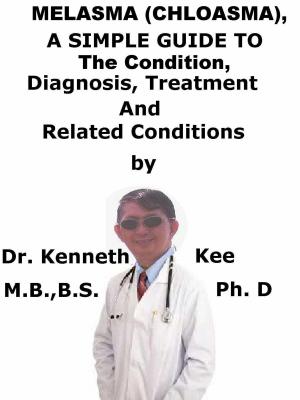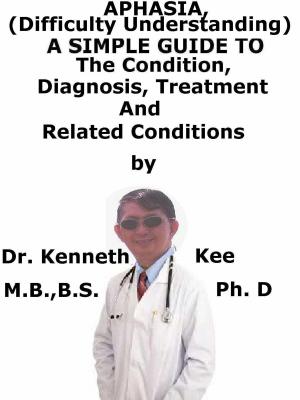Herniated Disk, (Slipped Disk) A Simple Guide To The Condition, Diagnosis, Treatment And Related Conditions
Nonfiction, Health & Well Being, Medical, Specialties, Orthopedics, Health, Ailments & Diseases, Musculoskeletal| Author: | Kenneth Kee | ISBN: | 9781370895281 |
| Publisher: | Kenneth Kee | Publication: | November 7, 2016 |
| Imprint: | Smashwords Edition | Language: | English |
| Author: | Kenneth Kee |
| ISBN: | 9781370895281 |
| Publisher: | Kenneth Kee |
| Publication: | November 7, 2016 |
| Imprint: | Smashwords Edition |
| Language: | English |
Herniated Disk or Prolapsed Inter-vertebral Disk is the medical disorder of prolapse of the inter-vertebral disk (which is the disk between 2 vertebrae) as a result of protrusion of the nucleus pulposus of the disk out of its weakened ligamentous ring (annulus fibrosus).
The disk may protrude in a posterior or posterolateral direction producing pressure to the nerve roots particularly at L4, L5 and S1 vertebrae.
Many doctors use the phrase “prolapsed disk” synonymously with terms such as “herniated disk,” “slipped disk,” and “ruptured disk.”
While this is fine for common usage, a prolapsed disk medically refers to the second of four stages of disk rupture.
Along the route to fully rupturing, the disks in the spine may pass through four distinct stages.
1. Disk Degeneration
During this stage, the outer walls of the inter-vertebral disks are weakened, but no visible external alterations have occurred.
2. Disk Prolapse
The outer wall of the disk begins to change shape and bulge out into the spinal canal.
The patient may begin to feel symptoms at this stage if the distended disk exerts pressure on the spinal cord or the nerve roots that extend from it.
3. Disk Extrusion
At this stage, the gel-like inner core of the disks has burst through a tear in the disk’s outer wall, but has not leaked out into the spinal canal.
4. Disk Sequestration
At this final stage, the gel-like substance has left the disk and has leaked into the spinal canal.
It is almost certain that the patient will feel symptoms at this stage, as the inner gel contains proteins that will inflame nerves that they come into contact with.
1. The most common symptom is Low Backache with pain in the lumbar region.
Pain may so bad that the person cannot stand erect.
2. There is a Sciatica or pain shooting down one leg
Physical Examination in a patient with suspected lumbar (lower back) inter-vertebral disk disease may feature the following:
a. Abnormal gait
b. Abnormal postures
c. Decreased lumbar range of motion
d. Positive straight leg raising test: Indicative of nerve root involvement
Spine MRI or CT will indicate that the herniated disk is pressing on the spinal canal.
The first treatment for a slipped disk is a short period of rest with medicines for the pain.
Initial phase:
1. Bed rest with a hard board below the mattress- straighten the back
2. Physiotherapy such as traction, shortwave diathermy
Mobilization phase:
1. Wearing a corset to straighten the back and help the traction of the spinal bones
2. Gradual mobilization and exercises to improve the strength of the spinal extensor muscles
Maintenance phase:
1. Exercises to strengthen the back muscles.
2. Wear a corset
3. Avoid postural strain on the back
Surgery is required if there are:
1. Persistent pain and neurological symptoms remain after conservative treatment
2. Progressive neurological symptoms
3. Disk has protruded more than 75% out of its inter-vertebral space as seen on MRI images
Surgery can be:
1. Laminectomy - removal of the disk and prolapsed material.
2. Microdiskectomy- insertion of a titanium disk to replace the removed prolapsed disk
TABLE OF CONTENT
Introduction
Chapter 1 Herniated Disk
Chapter 2 Causes
Chapter 3 Symptoms
Chapter 4 Diagnosis
Chapter 5 Treatment
Chapter 6 Prognosis
Chapter 7 Sciatica
Chapter 8 Neck Injury
Epilogue
Herniated Disk or Prolapsed Inter-vertebral Disk is the medical disorder of prolapse of the inter-vertebral disk (which is the disk between 2 vertebrae) as a result of protrusion of the nucleus pulposus of the disk out of its weakened ligamentous ring (annulus fibrosus).
The disk may protrude in a posterior or posterolateral direction producing pressure to the nerve roots particularly at L4, L5 and S1 vertebrae.
Many doctors use the phrase “prolapsed disk” synonymously with terms such as “herniated disk,” “slipped disk,” and “ruptured disk.”
While this is fine for common usage, a prolapsed disk medically refers to the second of four stages of disk rupture.
Along the route to fully rupturing, the disks in the spine may pass through four distinct stages.
1. Disk Degeneration
During this stage, the outer walls of the inter-vertebral disks are weakened, but no visible external alterations have occurred.
2. Disk Prolapse
The outer wall of the disk begins to change shape and bulge out into the spinal canal.
The patient may begin to feel symptoms at this stage if the distended disk exerts pressure on the spinal cord or the nerve roots that extend from it.
3. Disk Extrusion
At this stage, the gel-like inner core of the disks has burst through a tear in the disk’s outer wall, but has not leaked out into the spinal canal.
4. Disk Sequestration
At this final stage, the gel-like substance has left the disk and has leaked into the spinal canal.
It is almost certain that the patient will feel symptoms at this stage, as the inner gel contains proteins that will inflame nerves that they come into contact with.
1. The most common symptom is Low Backache with pain in the lumbar region.
Pain may so bad that the person cannot stand erect.
2. There is a Sciatica or pain shooting down one leg
Physical Examination in a patient with suspected lumbar (lower back) inter-vertebral disk disease may feature the following:
a. Abnormal gait
b. Abnormal postures
c. Decreased lumbar range of motion
d. Positive straight leg raising test: Indicative of nerve root involvement
Spine MRI or CT will indicate that the herniated disk is pressing on the spinal canal.
The first treatment for a slipped disk is a short period of rest with medicines for the pain.
Initial phase:
1. Bed rest with a hard board below the mattress- straighten the back
2. Physiotherapy such as traction, shortwave diathermy
Mobilization phase:
1. Wearing a corset to straighten the back and help the traction of the spinal bones
2. Gradual mobilization and exercises to improve the strength of the spinal extensor muscles
Maintenance phase:
1. Exercises to strengthen the back muscles.
2. Wear a corset
3. Avoid postural strain on the back
Surgery is required if there are:
1. Persistent pain and neurological symptoms remain after conservative treatment
2. Progressive neurological symptoms
3. Disk has protruded more than 75% out of its inter-vertebral space as seen on MRI images
Surgery can be:
1. Laminectomy - removal of the disk and prolapsed material.
2. Microdiskectomy- insertion of a titanium disk to replace the removed prolapsed disk
TABLE OF CONTENT
Introduction
Chapter 1 Herniated Disk
Chapter 2 Causes
Chapter 3 Symptoms
Chapter 4 Diagnosis
Chapter 5 Treatment
Chapter 6 Prognosis
Chapter 7 Sciatica
Chapter 8 Neck Injury
Epilogue
